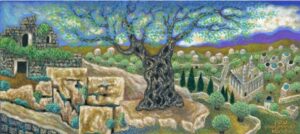בס”ד
By Rabbi Moshe Goodman, Kollel Ohr Shlomo, Hebron

In this painting we see a view from ancient Hebron located among the hills overlooking the Maarat
Hamachpela. It was in ancient Hebron where Avraham lived and also began the first Jewish battle, and
also where King David, “the fighter of the battles of Hashem,” (Shmuel I 25, 28) reigned first. This theme
of the Jewish battle is mentioned in the opening of this parsha – “ki tetze lemilhama.” Indeed, this parsha
deals in general with the “battles” and struggles of life. Hebron is also a symbol of Israel’s struggle battle
and victory – “nitzahon” – over ages – “netzach.” Complementing this theme we see in this painting
ancient olive tree signifying everlasting city of Hebron. Next to it are three trees perhaps hinting to three
Patriarchs. Then in the valley there are thirty such trees perhaps hinting to the extending aspect, I.e
through the multiplication by ten, of the three Patriarchs, heightened in the close vicinity to Maarat
Hamachpela.
There are 26 houses in the painting corresponding to the Tetrgrammaton. 15 are white-capped
corresponding to the more “heavenly” first two letters yod and heh, numerically equivalent to 15. Then
there are 6 multi-colored caps which may hint to the vav which is associated with connecting and
integrating various aspects. Then there are five black-capped houses which may hint to the malchut, I.e
the last heh, which the Kabbalists associate to black.



